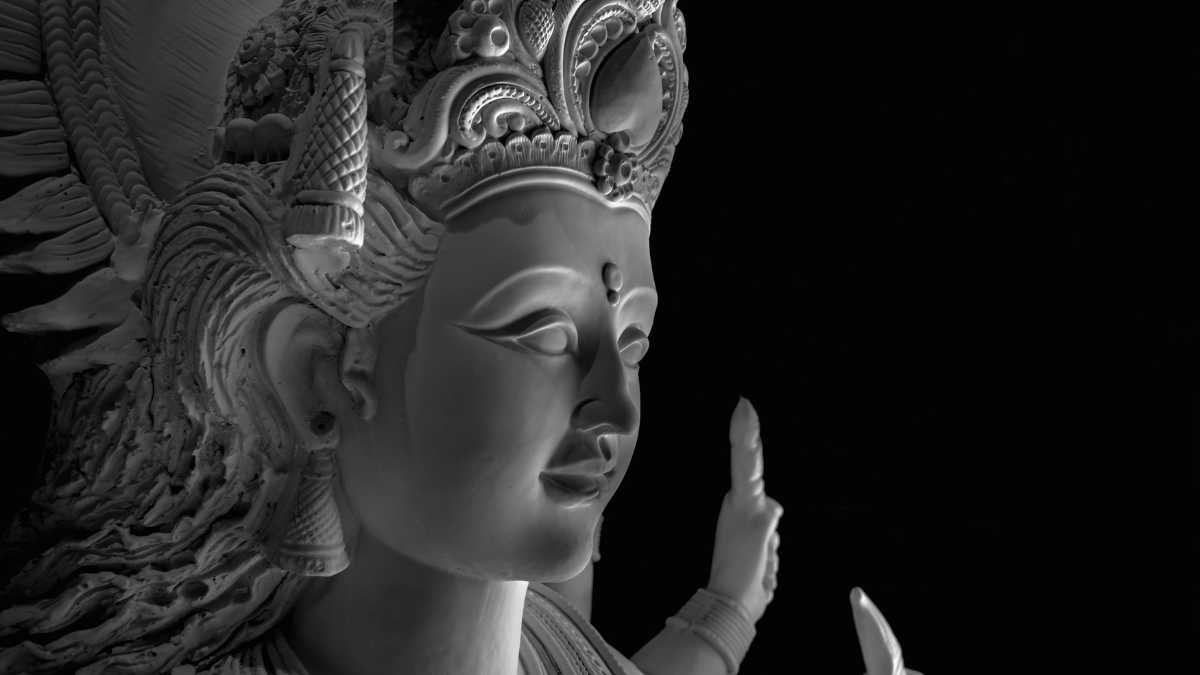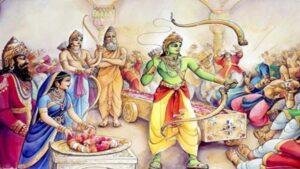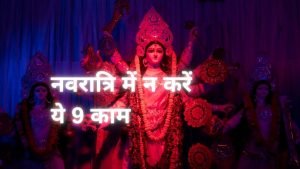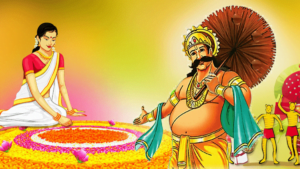The realm of Hindu mythology is adorned with a rich tapestry of stories, legends, and divine beings. Among these narratives, the tale of Mata Sati, a revered goddess, and the creation of Shaktipeeths holds a prominent place. Shaktipeeths are sacred pilgrimage sites scattered across the Indian subcontinent, each believed to embody a specific aspect of the divine feminine energy, Shakti. These sites are not only revered as religious centers but also serve as cultural touchstones that have woven themselves into the fabric of Hindu traditions.
At the heart of the Shaktipeeths lies the poignant story of Mata Sati, a primordial goddess and the consort of Lord Shiva, the divine destroyer. Her story traverses through cosmic love, intense devotion, and ultimate sacrifice. The legend of Mata Sati’s self-immolation at the Daksha Yagna, the subsequent mourning of Lord Shiva, and the creation of the 51 Shaktipeeths as sacred sanctuaries of her divine presence form the crux of this narrative. As we delve deeper, we shall explore the profound significance of these Shaktipeeths, their spiritual symbolism, and the enduring impact they continue to have on Hindu culture and worship.
Legend of Mata Sati and Creation of Shaktipeeths
The legend of Mata Sati and the creation of Shaktipeeths is a profound tale from Hindu mythology that highlights the power of devotion, sacrifice, and the cosmic balance between divine feminine and masculine forces. The story unfolds as follows:
1. Sati’s Birth and Marriage:
Mata Sati, also known as Parvati, was born as the daughter of King Daksha and Queen Prasuti. She grew up with deep reverence and love for Lord Shiva, the ascetic god of destruction and transformation. Despite Shiva’s unconventional appearance and demeanor, Sati’s devotion remained unwavering.
2. Daksha’s Yagna and Sati’s Immolation:
King Daksha organized a grand yagna (sacrificial ritual) and invited all the deities except Lord Shiva, whom he considered unfit for such gatherings. Ignoring her father’s wishes, Sati attended the yagna, where she was met with humiliation and disrespect. Unable to bear the dishonor and emotional pain, Sati invoked her inner power and self-immolated in the sacrificial fire.
3. Lord Shiva’s Grief and Tandava Dance:
Upon learning of Sati’s tragic fate, Lord Shiva was overcome with grief and rage. He performed the cosmic dance of Tandava, a fierce and destructive dance that shook the foundations of the universe. Shiva’s grief threatened to unravel creation itself.
4. Creation of Shaktipeeths:
To calm Lord Shiva and restore cosmic balance, Lord Vishnu intervened. He used his Sudarshana Chakra (discus) to dismember Sati’s body, which had been consumed by the fire. Her body parts fell at various locations across the Indian subcontinent, each becoming a sacred Shaktipeeth—a seat of divine feminine power.
5. Significance of Shaktipeeths:
These Shaktipeeths are considered potent energy centers where the divine feminine energy (Shakti) is worshipped. They symbolize the union of Shiva and Shakti, portraying the inseparable connection between the male and female aspects of the divine. Devotees visit these sites to seek blessings, healing, and spiritual transformation.
6. Devotion and Pilgrimage:
The legend of Mata Sati’s sacrifice and the creation of Shaktipeeths have inspired countless devotees to undertake pilgrimages to these sacred sites. Pilgrims believe that paying homage to these Shaktipeeths can grant them divine grace, fulfillment of desires, and liberation from the cycle of birth and death.
The legend of Mata Sati and the creation of Shaktipeeths stands as a testament to the enduring power of love, devotion, and sacrifice in Hindu mythology. It highlights the importance of recognizing the balance between divine energies and the profound impact of these Shaktipeeths on the spiritual landscape of India.
Major Shaktipeeths Associated with Mata Sati
Here are the major Shaktipeeths associated with Mata Sati:
- Vaishno Devi Shaktipeeth:
Location: Katra, Jammu and Kashmir, India.
Significance: Vaishno Devi is one of the most revered pilgrimage sites in India. It is believed to be the place where Mata Sati’s right arm fell. The temple is dedicated to Goddess Vaishno Devi, an incarnation of Mata Sati.
- Kamakhya Shaktipeeth:
Location: Kamakhya Hill, Guwahati, Assam, India.
Significance: Kamakhya Temple is a powerful Shaktipeeth where Mata Sati’s genital (yoni) is believed to have fallen. It is a major center of tantric worship and is associated with the goddess Kamakhya.
- Kalighat Shaktipeeth:
Location: Kolkata, West Bengal, India.
Significance: Kalighat Temple is dedicated to Goddess Kali and is one of the 51 Shaktipeeths. It is said to be the place where Mata Sati’s toes fell. The temple is known for its fierce form of Goddess Kali.
- Ambaji Shaktipeeth:
Location: Ambaji, Gujarat, India.
Significance: Ambaji Temple is a revered shrine dedicated to Goddess Amba or Ambaji, considered to be a manifestation of Mata Sati. It is believed that Mata Sati’s heart fell at this location.
- Jwalamukhi Shaktipeeth:
Location: Kangra, Himachal Pradesh, India.
Significance: Jwalamukhi Temple is famous for its eternal flames that are considered a manifestation of the goddess’ power. Mata Sati’s tongue is believed to have fallen here, symbolized by the flames.
These Shaktipeeths hold immense spiritual and cultural significance in Hinduism, and pilgrims visit them to seek blessings and connect with the divine energy associated with Mata Sati. Each Shaktipeeth has its unique legends, rituals, and practices, contributing to the rich tapestry of Hindu religious heritage.
Symbolism and Spiritual Significance of Shaktipeeths
The symbolism and spiritual significance of Shaktipeeths inspire devotees to recognize the interplay of cosmic energies, honor the divine feminine, and embark on a transformative journey towards self-realization and spiritual awakening.
- Cosmic Energy Centers:
- Shaktipeeths are believed to be powerful cosmic energy centers where the divine feminine energy (Shakti) is concentrated.
- Each Shaktipeeth is associated with a specific body part of Mata Sati, symbolizing the interconnectedness of cosmic energy with different aspects of creation.
- Unity of Shiva and Shakti:
- Shaktipeeths represent the union of Lord Shiva (divine masculine) and Mata Sati (divine feminine) energies, reflecting the foundational concept of balance and harmony in Hindu philosophy.
- The sites embody the idea that both male and female energies are essential for cosmic creation and sustenance.
- Purification and Transformation:
- Devotees believe that visiting Shaktipeeths helps in purifying the soul and cleansing oneself of negative energies and impurities.
- The journey to these sacred sites is seen as a transformative experience, leading to spiritual growth and self-realization.
- Manifestation of Divine Power:
- Shaktipeeths are seen as places where the divine power of the goddess is particularly potent and accessible.
- The energy of the Shaktipeeths is believed to facilitate healing, protection, and empowerment for those who seek the goddess’s blessings.
- Worship and Devotion:
- Shaktipeeths are places where devotees can honour the goddess and ask for her blessings on different aspects of life, including health, wealth, and relationships.
- At these locations, worship is a chance to interact with the divine and strengthen one’s spiritual connections.
- Unity in Diversity:
- The network of Shaktipeeths across different regions emphasizes the unity and diversity within Hinduism, showcasing the varied ways in which the goddess is revered and celebrated.
- Spiritual Pilgrimage:
- Visiting Shaktipeeths is considered a sacred pilgrimage, allowing devotees to detach from worldly concerns and focus on their spiritual journey.
- The physical journey mirrors the inner quest for self-discovery and spiritual enlightenment.
- Elevation of Feminine Power:
- Shaktipeeths celebrate and elevate the divine feminine principle, underscoring the importance of women and their roles in creation, sustenance, and transformation.
- Eternal Connection:
- Shaktipeeths create an eternal connection between devotees and the goddess, fostering a sense of devotion, surrender, and divine love that transcends time and space.
- Cultural and Mythological Heritage:
- Shaktipeeths preserve and propagate ancient myths and stories related to Hindu gods and goddesses.
- They play a significant role in transmitting cultural values, traditions, and narratives from generation to generation.
Conclusion
The tale of Mata Sati and the creation of Shaktipeeths stands as a testament to the profound spiritual depth and cultural richness within Hindu mythology. These sacred pilgrimage sites, scattered across the Indian subcontinent, represent not only religious centers but also symbols of cosmic balance and the divine union of Shiva and Shakti. The legend of Mata Sati’s sacrifice exemplifies the enduring power of love, devotion, and selflessness. As devotees embark on pilgrimages to these Shaktipeeths, they seek purification, transformation, and a deeper connection with the divine feminine energy. These sites serve as bridges between earthly and celestial realms, fostering unity amidst diversity and embracing the eternal link between the human soul and the divine. The Shaktipeeths continue to weave their significance into the intricate fabric of Hindu culture, guiding spiritual seekers on a journey of self-discovery and reverence for the timeless principles they represent.



















Add comment